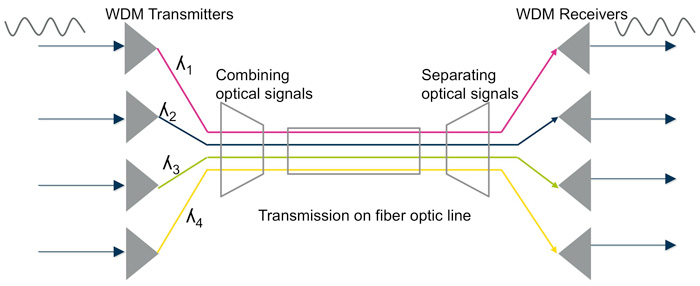OFC 2024: Researchers achieve 12-spatial-channel WDM/SDM transmission over transoceanic distance
Researchers have achieved wave/space-division multiplexed (WDM/SDM) transmission across a transoceanic distance of 7280 km with an unprecedented 12 spatial channels using a coupled multi-core fiber with a standard cladding diameter. This accomplishment opens new possibilities for increasing the capacity of current submarine cabling technology using fiber technology that doesn’t take up more space.
This research, collaborated with NEC Corporation and NTT Corporation in Japan, will be presented by Manabu Arikawa from NEC Corporation at OFC, the premier global event for optical communications and networking, which will take place as a hybrid event 24 – 28 March 2024 at the San Diego Convention Center.
“Submarine cable systems are vital infrastructure for our lives, connecting the world across oceans; future cables require more and more capacity because of the exponentially growing global traffic demand,” said Arikawa. “This research result can lead to higher capacity submarine cables, reduced cost per transmitted bit, and more efficient connectivity by significantly increasing the number of spatial channels for the same amount of optical fibers in the cables.”
WDM and SDM are used to maximize the capacity and efficiency of optical fiber communication systems. WDM works by transmitting multiple signals simultaneously over a single optical fiber by assigning each channel a unique wavelength of light whereas SDM uses separate spatial paths or fiber cores to transmit multiple data streams within a single optical fiber or across different fibers.
For submarine cables, achieving more than 10 spatial channels has only been demonstrated for transmission distances of up to 1001 km with a 15-mode fiber or 1560 km with a 10-mode fiber. The challenge to achieving high spatial count transmission over transoceanic distances is to find a way to reduce the spatial mode dispersion (SMD) and mode-dependent loss (MDL) of the transmission line. Multi-core fibers are good candidates for this because their multiple individual cores can each carry an optical communication channel, allowing parallel data transmission. Compared to the uncoupled version, coupled multi-core fibers can accommodate many more cores in a standard 125-µm diameter cladding.
In the new work, the researchers carried out WDM/SDM transmission using a 32-G baud PDM-QPSK modulation format over a recirculating loop consisting of a single 52-km length of coupled 12-core fiber (C12CF) with a standard cladding diameter. After determining the optimum span input power, they evaluated transmission performance at three wavelength ranges in the C-band.
They observed error-free transmission after forward error correction for wavelengths up to 7280 km (140 loops) for 1536.6 nm and up to 9360 km (180 loops) for 1550.9 nm and 1560.6 nm in a single-span loop configuration. They also demonstrated a spatial mode dispersion of 0.1 ns and mode-dependent loss of 0.3 dB per 52-km C12CF span, together with relatively low wavelength dependence.
“One of the following important steps is the evaluation of large-scale multiple-input multiple-output (MIMO) processing in real-time implementation from the point of view of the future realization of a MIMO transceiver for optical communication,” said Arikawa. Another important topic is the impact and scalability of the MDL of the fibers with the number of spatial channels to characterize and overcome this capacity limitation in the future.
………………………………………………………………………………………………………………………………………………………………………………………………………….
Wave Division Multiplexing (WDM) is one of the optical multiplexing techniques that increases bandwidth by multiplexing a variety of optical carrier signals onto a single optical fiber by using different wavelengths. Each signal at WDM wavelengths is independent of any protocol and any speed. WDM technology allows bidirectional communications simultaneously over a single optical fiber. The foundation of WDM simplifies the network to a single virtual optical fiber network instead of using multiple forms of signals with different fibers and services. In this way, WDM increases the bandwidth and lowers the networking cost by reducing the needed fibers.
There are two different wavelength patterns of WDM system, coarse wave division multiplexing (CWDM) and dense wavelength division multiplexing (DWDM). CWDM and DWDM are based on the same concept of using multiple light wavelengths on a single fiber, but differ in the spacing of the wavelengths, numbers of channels, and the ability to amplify the multiplexed signals in the optical space. In a WDM system, different optical signals are combined (multiplexed) together at one end of the optical fiber and separated (demultiplexed) into different channels at the other end.

………………………………………………………………………………………………………………………………………………………………….
About OFC:
OFC, the premier global event for optical communications and networking, attracts attendees from around the world to a conference and exhibition that showcases the latest industry advancements and emerging technologies. This global event serves as the platform for start-ups to make their debut and industry leaders to set the pace for what’s to come. A compelling series of exciting programs and events will cover the entire ecosystem with a focus on inclusivity.
About Optica:
Optica (formerly OSA), Advancing Optics and Photonics Worldwide, is the society dedicated to promoting the generation, application, archiving and dissemination of knowledge in the field. Founded in 1916, it is the leading organization for scientists, engineers, business professionals, students and others interested in the science of light. Optica’s renowned publications, meetings, online resources and in-person activities fuel discoveries, shape real-life applications and accelerate scientific, technical and educational achievement. Discover more at: Optica.org
References:
https://opg.optica.org/jocn/fulltext.cfm?uri=jocn-11-3-1&id=404247


